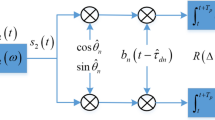Abstract
The phenomenon of pseudorange bias, which is also called S-Curve bias, becomes more obvious with the combined use of multiple satellite systems or navigation satellites with different phases. The different characteristics of the transmitting channel of a navigation satellite result in different distortions of the pseudorange bias in navigation signals; in particular, this issue worsens when the RF channel is not optimized to decrease the pseudorange bias. Therefore, it is interesting to reveal the essential relationship between pseudorange bias and the non-ideal channel and to present an analytic model of the effect of a non-ideal channel on pseudorange bias. Instead of using the numerical method of finding the bias of the zero-crossing point of the discriminator, we provide a theoretical evaluation of the S-Curve bias for the given parameters of channel and signals. Based on the model and presented analyses, we find that second-order group delay plays an important role in the distortion of S-Curve bias and should be avoided in the design of the RF channel for navigation satellites and receivers.

















Similar content being viewed by others
References
China Satellite Navigation Office (2018) BeiDou navigation satellite system signal in space interface control document open service signal B3I (Version 1.0). http://beidou.gov.cn/xt/gfxz/201802/P020180209623601401189.pdf. Accessed 15 Dec 2018
European Union (2013) European GNSS (Galileo) open service signal in space interface control document. https://galileognss.eu/galileo-os-sis-icd/. Accessed 15 Dec 2018
Global Positioning Systems Directorate (2018) Navstar gps space segment/user segment L5 interface. https://www.gps.gov/technical/icwg/. Accessed 15 Dec 2018
Gong X, Lou Y, Zheng F, Gu S, Shi C, Liu J, Jing G (2018) Evaluation and calibration of BeiDou receiver-related pseudorange biases. GPS Solut 22(4):22–98
Guo NY, Kou YH, Zhao Y, Yu Z, Chen Y (2014) An all-pass filter for compensation of ionospheric dispersion effects on wideband GNSS signals. GPS Solut 18(4):625–637
Hauschild A, Montenbruck O (2016) A study on the dependency of GNSS pseudorange biases on correlator spacing. GPS Solut 20(2):159–171
Kaplan ED, Hegarty CJ (2006) Understanding GPS principles and applications, 2nd edn. Artech House, Norwood
Rapisarda M, Angeletti P, Casini E (2007) A simulation framework for the assessment of navigation payload non-idealities. In: Proceedings of 2nd workshop on GNSS signals & signal processing (GNSS SIGNALS’2007), At ESA/ESTEC Noordwijk, The Netherlands, April 24–25
Rebeyro E, Macabiau C, Julien O, Ries L, Issler JL, Bousquet M, Boucheret ML (2006) Signal distortions at GNSS payload level. In: Proceedings od ION GNSS 2006, Institute of Navigation, Fort Worth, Texas, USA, September 26–29, pp 1595–1605
Sha H, Guan G, Wang H, Chu H (2018) Research and analysis of S curve bias evaluation method in GNSS signals. In: China satellite navigation conference (CSNC) 2018 Proceedings. Springer, Singapore, pp 171–181
Soellner M, Kohl R, Luetke W, Erhard P (2002) The impact of linear and non-linear signal distortions on Galileo code tracking accuracy. In: Proceedings of ION GPS 2002, Institute of Navigation, Portland, OR, USA, September 24–27, pp 1270–1285
Soellner M, Kurzhals C, Hechenblaikner G, Rapisarda M, Burger T, Erker S, Furthner J, Grunert U (2008) GNSS offline signal quality assessment. In: Proceedings of ION GNSS 2008, Institute of Navigation, Savannah, Georgia, USA, September 16–19, pp 909–920
Zhu X, Li Y, Yong S, Zhuang Z (2009) A novel definition and measurement method of group delay and its application. IEEE Trans Instrum Meas 58(1):229–233
Author information
Authors and Affiliations
Corresponding author
Additional information
Publisher's Note
Springer Nature remains neutral with regard to jurisdictional claims in published maps and institutional affiliations.
Rights and permissions
About this article
Cite this article
Liu, Y., Chen, L., Yang, Y. et al. Theoretical evaluation of group delay on pseudorange bias. GPS Solut 23, 69 (2019). https://doi.org/10.1007/s10291-019-0861-z
Received:
Accepted:
Published:
DOI: https://doi.org/10.1007/s10291-019-0861-z




